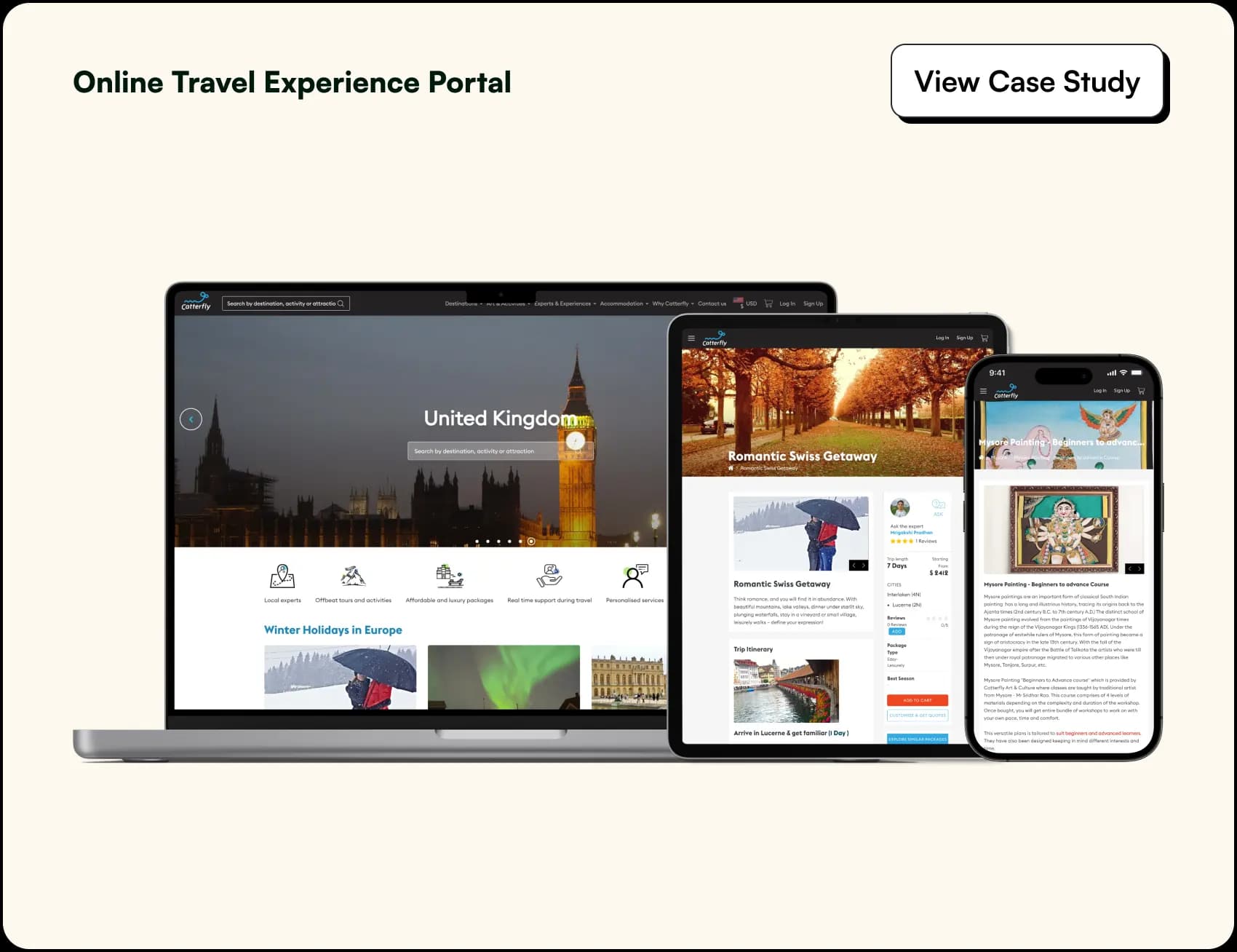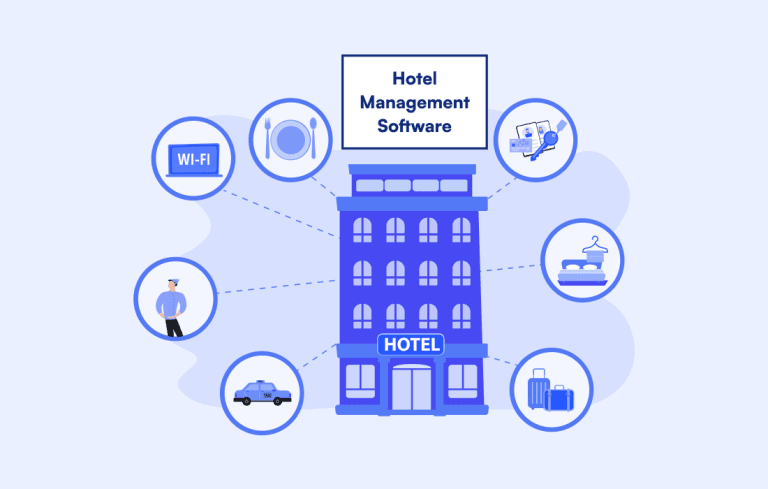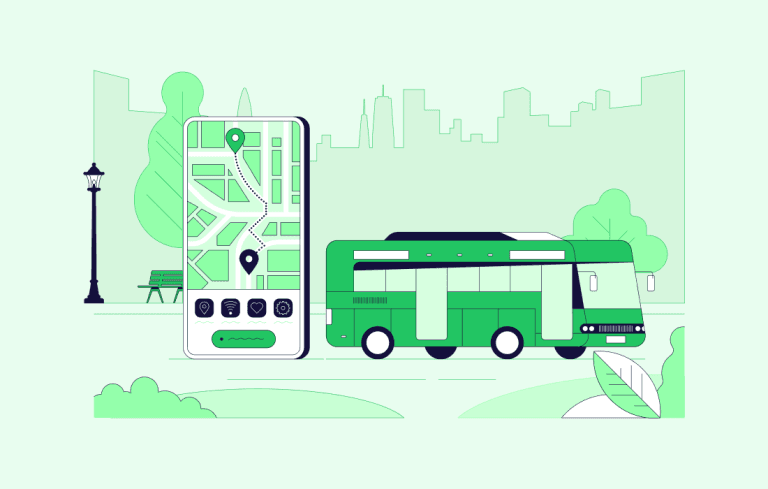How To Develop A Travel Planner App Like TripIt and Wanderlog?
Follow our in-depth travel planner app guide if you want to be the next travel unicorn in the making. Dive deep into the features, benefits, and steps to develop. Get a travel planner app like Wanderlog or TripIt.

Scenario 1:
In the midst of planning a trip, you are struggling to find the best price for a solo trip. Wondering, if there is such an app that can solve your doubts?
Scenario 2:
The day-wise itinerary is ready, but you are struggling to organize your information. What if there is an app feature that organizes all your travel info in one place? Then, you are all set to explore your dream destination.
Scenario 3:
You are enjoying your trip. Day 1 of Destination 1 is done. You are happy and excited about what’s next. On day 2 of your itinerary, you moved to Destination 2 and learned that the best place in the world to have muffins was in Destination 1. You are now irritated. If you had an app that could tell you the best places to eat at a destination.
Solution: A travel planner app
This is what a user wants. We understand you might have faced one of these situations while planning your travel app, and you decided to get your own travel app to work on all the user woes. A shout-out to all the travel business owners, travel entrepreneurs, and entrepreneurs on their way to becoming the next unicorn. Here, we have organized all the information you need to get a travel planner app and achieve your goal. Letâs jump in –
Table of Contents
What is a Travel Planner App?
An app that can help travelers plan, book, and organize their travel and other information is a travel planner app.
An app for travel planning can make organizing a vacation more fun. It is a travel companion that helps people plan their travels. That’s just a broad description because it all depends on your perception of what users could genuinely accomplish with your travel planner software.
From this vantage point, we may separate modern travelers into two basic categories: those who prefer traveling without any planning and those who want to plan everything beforehand. Each of these groups requires a separate set of features, which will set your app apart. For example, you could create an app that generates a comprehensive itinerary (like the Journeasy app), or you could give them the option to build the itinerary with Generative AI.
Why is it a Good Idea to Invest in a Travel Planner App?

Investing in a travel planner app becomes necessary due to these reasons –
1. Increasing Inclination towards Travel Planner Apps
User requirements are evolving, but they are doing so predictably. Nearly half of the respondents said they would prefer to use the Travel planning apps to book everything, including hotels, flights, and taxis. This implies that people want to manage the entire tripânot just the bookingâwith a single app, so why not yours?
Imagine developing an app that lets users reserve anything they wantânot only lodging, transportation, or tickets to museums, theaters, or swimming poolsâand have it immediately added to their schedule. What happens if your app becomes their one-stop shop for all things vacation-related? That is noteworthy!
2. The Growing Business of the Travel Industry
The travel industry is a growing business. As of 2024, the travel and tourism sector generates US$927.30 billion in revenue. By 2028, it’s expected to have grown to a $1063 billion US market. The revenue speaks volumes of how well the business is growing. With numbers on our side, it is pretty much apparent that the future of the travel industry is very bright. Wanderlog and TripIt are some of the best travel planning apps.
3. Convenience and Better Experience
You may improve people’s lives and expand your business by developing apps for travel planning. You greatly influence their holiday experience and general well-being. The flexibility of using a travel planner app to organize your journey at any time and from any place is one of its main advantages. With the use of these applications, organizing trips has become incredibly easy. Travelers get instant access to all the information they require for their trip, including airline information, hotel reservations, and details on nearby attractions and activities.
4. Organization of Information
Using the apps that are now available on the market does not satisfy users. Many of them offer processes that are overly complex or counterintuitive, ignore user needs, or call for an excessive amount of human labor. And the information. User needs a one-stop solution, a travel planning application that can store, organize, and remind important travel information that helps before or during the travel. Information like travel tickets, personal IDs, and checklists.
What Key Features Can You Expect in a Travel Planner App
Let us take an example of a cake analogy.
Features are like sugar in a cake; the more you add, the sweeter it gets.
However, a word of caution: Include only so many features in the application that facilitate user convenience. Adding too many features can mess with the user experience.
An irritated user is more dangerous than a disappointed one!
Generic Feature This category includes the list of features that almost all the best trip-planning apps include. Including these features will give you a basic travel planning application that will work fine with as many features as you want to add.
This category includes the list of features that almost all the best trip-planning apps include. Including these features will give you a basic travel planning application that will work fine with as many features as you want to add.
- Search
- Booking Integration
- Customer Support
- Offline Availability
- Suggestive Travel Guide
- User Reviews
- Social Media Integration
Smart Features
Smart features in a travel planning app are like additional flavoring. Like the way you add vanilla for a vanilla cake or strawberry for a strawberry cake.

- AI-generated Itinerary
- Personalized Recommendations
- Customizations
- Compare Your Trips –
- Packing List
- Budget and Expense tracker
- Globe GUI Integration
- Calendar Syncing
- AI-powered Chatbots
1. Search Functionality
It is a basic functionality that any travel planning app requires. Search can list destinations, restaurants, or any adventurous activities of the place.
Search PlacesÂ
Along with the top attractions users also look for the lesser-known places to visit when going to a new destination. Additional tabs like Must-visit Places also promote the search feature making it the king of all features.
Additional Note section lets you add the details and points to remember, you came across in your research. If you have selected Paris to visit, in Notes, you can add -âdonât forget to try Fashion Street.â Common phrases like Salut! Commo ca va?, Ou est la Eiffel Tower? And so on. Adding common language phrases can ease your travel planning and reduce your anxiety about foreign languages.
Search Fun Activities
Apps like Klarna Trips show places that offer fun activities. Activities are dependent on the places: beaches will provide water activities, mountain places will provide trekking activities, and so on. Some apps offer booking facilities for such activities.
Search RestaurantsÂ
Any trip is incomplete without good food to eat. Adding a feature to search for a suitable restaurant helps the user to plan the trip easily. If a good food place is located between two must-visit destinations, then just by having a look at the travel planning map, the user can change the itinerary to accommodate the visit and save time.
2. Map Integration
It brings us to map integration. Integrating a map into the travel planner app makes it more convenient for the user. A great feature that Wanderlog shows is that when you add a place to your itinerary it pins it on the map. Even TripIt has the same feature and even the pins have numbers to specify your marked places in the itinerary. If you see your first destination is opposite to the second destination, then simply by looking at the map you can rearrange the itinerary.
3. User-Generated Reviews and Ratings
The reliability of the information a travel app provides to its customers determines how popular it is. The ratings, reviews, and suggestions that users and the app’s content creators post are the basis of this reality. A restaurant gains more credibility than content supplied by the administratorâwhere users are not allowed to leave comments or offer personal recommendationsâif a significant number of verified passengers have given the establishment ratings. Additionally, this increases awareness and enhances the services provided by cafes, motels, and other businesses. Travel app developers should just include these features in their current products rather than making consumers download extra apps.
4. Booking Facilities
Travel planning apps have all the facilities like booking lodging, conveyance, or rentals. These apps act as a travel buddy that can help with all travel needs.
Lodging facility
The first basic need comes to booking a lodging facility when traveling. There are different options for lodging â hotels, hostels, and dormitories. It depends on what popular lodging options are there in a given location.
Conveyance booking facility
Reaching a location and then booking any conveyance should be present in any travel planning app. The flight, bus, and train booking facility is generally integrated into the app and redirects the user to the third-party apps. It becomes convenient for the user, and your travel planner app can become a one-stop solution for all traveling needs.
Rentals
This is an exciting feature that is nowadays integrated into the apps for travel planning. Users now prefer to rent a cab or bike to explore the destination while traveling. It saves the cost and time.
5. Suggestive Travel Guide Integration
Travel planning requires a lot of research, and if the user gets all the best guides integrated into the application, then itâs a win-win situation. This creates more user engagement. Users can look into guides without leaving your travel planner app. You can ask the developer to integrate guides according to the target audience, and you can get it updated in the future.
6. Social Media Integration
In the world of Instagram and Snapchat filters users want to share every moment of their adventure on social media. It becomes mandatory to integrate social media and is a strategic move that along with the tagging, your travel planner app gets the due marketing.
7. Customer Support
Excellent customer support is another feather in the features cap. It can make or break the application, especially when it caters to a customer-centric industry. Customer support helps in areas where a user is stuck and can get help creating distinct support.
8. Offline Availability
Offline accessibility of travel maps and information makes the travel experience better, especially when traveling in lower connectivity areas or with no connectivity.
Smart Features & Customizations
 Features like smart voice search, the use of AI, or an AI trip planner, etc., make the travel planning application a bit more trendy. Journeasy is one such example of using âBuild with AIâ trip planning. The AI suggests a trip plan to fit your travel preferences.
Features like smart voice search, the use of AI, or an AI trip planner, etc., make the travel planning application a bit more trendy. Journeasy is one such example of using âBuild with AIâ trip planning. The AI suggests a trip plan to fit your travel preferences.
1. Weather Forecasting
Sunshine and warmer temperatures make it a good time of year for visitors in Europe to explore new places, according to a study on the impact of weather on travel enjoyment. Therefore, the app for planning travel must incorporate the impact of weather on travel. To help with better planning of one’s transportation and trip time, a real-time weather forecast function can be useful. Thanks to this tool, users will be able to avoid natural disasters and stay informed about the weather. Adding a weather component to your app may prevent travelers from opening a different app to check the conditions. The weather prediction function ought to furnish them with an all-encompassing synopsis of the anticipated wind velocity, cloud formations, and relative humidity.
2. Personalized Recommendations
By connecting your travel app to social media platforms or Google services, you may obtain additional information about your users and utilize artificial intelligence (AI) to give them recommendations and information that is even more accurateâsometimes even before they ask for it.
With Generative AI development in the picture, there is so much that can be done in the travel industry. Suppose, with the help of big data, you have information that the user is looking for an eco-friendly trip. You can easily place fairly customized eco-friendly trip suggestions for the user, which will hardly go wrong.
3. Customizations
These travel applications let you customize your vacation to your tastes, whether you’re planning a solo trip, group outing, honeymoon, or any other kind of journey. You are free to personalize itineraries based on your tastes, interests, and budget.
Gone are the days when you had to adjust to the travel plans given by the agents and think about your preferences. The recent travel trends include Solo trips, Eco-Friendly Trip suggestions, Travel according to the weather, and many other options. The customization can be done with AI-generated suggestions as well.
4. Compare Your Trips
The most common thought every traveler must be getting is just like phones; I could compare my trip. This is a brilliant feature to add to the feature list. Users can easily compare the trips so they can weigh the pros and cons of all the options available to them.
5. Packing List or Essentials
Away from home, users need all the things that make the trip memorable. Be it medicines, tickets, passports, or any other essential. The same happens while packing. If the travel planner gets you covered here with the essentials, then it becomes a relaxing moment for the users. It’s a smart idea to include a packing list.
6. Budget and Expense tracker
One major and very concerning issue users come across is tracking the expense on a trip. While traveling, it often becomes a thing that you over boarded your set budget. Consequentially, pushing your next trip a few more months or years. An expense tracker helps maintain your budget and lets you add your expenses easily.
7. Globe GUI Integration
Apps like Travopo have this exciting feature of Globe GUI integration. Users can tap the globe in the app and tap on any location to get more information. This is an innovative feature to add to the traveler companion app to make trip planning much more exciting.
8. Calendar Sync
The calendar in your trip planning software can be accessed in a variety of ways. All of the information can be immediately transferred from the travel planner app to the calendar, or the other way around, from the calendar to your app. You may need to go through the verification process (e.g., the Google Calendar setup) if you wish to display the schedule as a calendar. Remember that there may be additional costs involved.
9. AI-powered Chatbots for Travel Planning
AI made its way into our everyday lives. Another way to implement AI in travel planning is AI-powered chatbots for travel planners. Bunji is an AI chatbot on Queenslandâs website that helps users as a virtual expert travel guide. The AI-powered assistant is filled with information and can easily guide users about different places in Queensland, Australia.
What is Wanderlog and How is it Different?
Many users find it enjoyable to receive travel destination recommendations. Wanderlog is arguably the greatest app for doing this. They include appropriate suggestions for individual activities, sites to visit, dining options, etc., right onto the map and in the schedule. To provide you with additional context for user research, they also recommend content from TikTok and YouTube. Lastly, they have thorough guides and itineraries created by other tourists.
The maps are well designed, with color-coded markers that illustrate your schedule by day and that allow users to filter the data. Wanderlog can organize information with as much detail as the user chooses.
How Does TripIt Stand Out from Other Travel Planning Apps?
The most useful aspect of TripIt is its ability to information organization, such as the kind of food a restaurant offers or the email address of a particular acquaintance. An additional useful feature is the ability to export your itinerary as a.ics file for your calendar.
Steps to Develop a Travel Planner App Like Wanderlog or TripIt

When you are opting to develop an app, it is better to collect all the necessary information. Here is a detailed travel app development guide. Building a travel planner app requires multiple steps like
- Discovery Phase
- System Analysis & Design
- Development Phase
- Testing Phase
- Launch, Support & Maintenance
1. Discovery Phase
Gathering information and doing preliminary preparation is usually necessary for any business idea. It becomes essential to comprehend the Discovery Phase in App Development and the app idea’s market trends. Travel trends change, and with them, the demands of consumers. To succeed in this situation, you must comprehend your target market, their buying habits, and their budget range. You must operate inside that range.
Analyzing competitors is the next crucial step. You may determine what values and solutions your brand will offer if you have a clear understanding of what your competitors are delivering. Having gathered all the material, you can create a preliminary outline.
2. Designing and UI/UX Principles
Designing principles are like the cherries or decoration on the top. You have got your cake(Travel Planning app) and now you can decorate it the way you want. The better the decoration the better will be the user experience. Below is the checklist you can refer to when designing a travel planning app.
Checklist for designing a travel planner app –
- Intuitive and straightforward layout
- Visually pleasing design
- Personalization and customization
- Fast loading times and responsiveness
- Screen optimization for various devices
3. Development Phase
The segregation of development tasks allows the project’s code to be written in modules usually. Writing code in modules reduces delays and disturbances while enabling more accurate evaluations. Additionally, it guarantees that any client feedback can be included right throughout the development process. At this point in the software development process, tracking tools are essential for monitoring the project’s progress.
An additional requirement for travel planner apps is security. These applications deal with both personal and financial data. To guarantee the highest level of security, the developers must add an additional layer of security for the sensitive data.
4. Testing Phase
The testers enter the picture when the development and coding are completed. In order to check for defects in the application, testers and quality assurance personnel work on the final project. Any malfunctions or faults encountered when utilizing the program are reported as problems and returned to the developers for resolution. Once more, the app is examined for errors and tested. The buy now pay later software is prepared for distribution after it has been tested by QA and testers.
5. Launching and Marketing
Launching your application on the respective platform; for Android apps its Google Play store and iOS apps App Store. Then comes the marketing and campaigning of your application. Spreading the word about your application and making a buzz around it can place it in the hands of your target audience. Today influencer marketing, email campaigning, and other forms of marketing also are very active methods of marketing.
As important as it is to convert new users, it is equally important to retain the old ones. User retention is what speaks about the success of any application. You can keep these points in mind while marketing any travel planning app –
- Unique Value Proposition (UVP)
- App Store Optimization (ASO)
- Marketing Campaigns
- Influencer Marketing
- Promotional Incentives
6. Maintaining Your Travel Planner App
App maintenance is a crucial phase for sustainable app growth. Talk in advance with the bespoke mobile app development company about the post-launch support. It includes the following points –
- Continuous Improvement
- Scalability
- Security and Data Protection
- App Monitoring and Analytics
Technical Stack is used for Travel Planner Apps like Wanderlog
- Mobile app development frameworks
- Backend development
- Database management
- API integration
A Monetization Strategy that Helps
Creating apps for travel planning requires a large financial commitment and the goal is to turn a profit. As a result, if you can create an eclectic app and draw in a sizable user base, your app can generate a lot of income. Such apps act as your travel companion and can help with all your travel needs. The most popular methods for apps to generate revenue are as follows:
1. Purchases Made Within Apps
In-app purchases are often required for consumers to access certain features in basic editions of many applications. As a result, the app enjoys a fantastic revenue stream from this purchase.
2. Upgraded Editions
A popular approach to generating revenue is providing upscale versions or premium versions. Users are required to pay for premium services when using Roadtrippers. That is one method of making money. Developers encourage customers to upgrade to the premium version by offering the basic version for free. Once the users have a taste of the free version of the application and are engaged, then they wonât mind paying a fixed amount and will be able to access more features.
3. Making Money Through Marketing and Promotions
The software will generate a significant profit from ads if it has been successful in attracting a substantial user base. Promos and advertisements are excellent ways to get quick cash.
4. Commission-based Partnerships
Most travel and tourism applications operate on a commission-based business model. The service providers receive a certain charge in exchange for bringing in customers.
5. Promoted Listings
The listing fee is an alternative to the commission-based business model. Some applications don’t take a cut of every transaction; instead, they only charge the service providers a listing fee to appear on the app.
What is the Cost of Developing a Travel Planner App?

Factors influencing how much it costs to create an app for travel planning
- Key features of the product
- Product design
- Cost of the development team
- The size and complexity of the project
- Technology stack
- Total team members involved in the project
- Time limit
- Developer’s skill set and expertise
- Platforms to develop
- Infrastructure Cost
The hourly rate of developers is the primary factor that affects a project’s cost. The hourly rate varies based on the location where the developers are hired. For example, the cost of developing a travel planner app is approximately $15,000â20,000 if you hire mobile app developers in India. However, it might cost between $35,000 and $40,000 to develop the same app in North America. The fact that living standards differ from location to location is a straightforward explanation for this. Geographical location, the time a developer invests, and the expertise level are some factors that directly influence the cost of any project.
How Can SolGuruz Help You Make a Travel Planner App like Wanderlog?
When creating a travel planning app similar to TripIt or Wanderlog, SolGuruz is your go-to partner. We provide knowledge, experience, and creativity to realize your idea.
SolGuruz is aware that companies with distinct needs call for distinctive solutions. Our team focuses on the finer points to provide a customized solution that meets the needs of the target market and complements your company objectives. See the adventure that online travel portal development took.
SolGuruz has a team of highly qualified engineers and developers, and they have a lot of expertise in using the newest technology to create scalable and reliable apps. We make sure that the backend architecture, frontend frameworks, and payment methods of your trip planner software are strong enough to support the needs of an expanding user base.
Conclusion
Developing a travel planner app is a great idea if you know what is needed and whom to contact. A custom mobile app development company like SolGuruz can help you develop a travel app and place your app in the likes of Wanderlog and TripIt.
FAQs
1. What makes travel planner apps superior to other conventional means of trip planning?
Travel planner apps are a convenient way to plan your trip, keep information handy, and book all your tickets. With all these features in one place, travel planner apps become the go-to solution for travelers.
2. What features do I need to look for in a travel app to guarantee a seamless and well-planned trip?
Features like search, booking facility, and offline availability are basic. For more advanced planning, look for weather forecasting, reviews, and smart AI-powered assistant suggestions.
3. Do travel planning applications only manage lodging and flights, or do they offer additional functions to enhance the trip experience as a whole?
It depends on the appâs functionalities. Some apps, like Wanderlog, provide comprehensive information, while others, like TripIt, focus on information organization and may skip some features.
4. Do travel planning apps facilitate group travel by enabling the sharing and coordination of itineraries among multiple users?
Yes, travel planner apps often offer group sharing features, making it easy to coordinate itineraries. You can also share your trips on social media platforms.
5. Does the travel app need to be integrated with a payment gateway?
Travel planner apps generally integrate third-party services for bookings. It is advisable to discuss your needs with the travel app development company to ensure appropriate payment integration.
Build Your Travel Planner App
Turn your idea into a successful travel planner app with SolGuruz. Start your development journey with us.

Strict NDA

Trusted by Startups & Enterprises Worldwide

Flexible Engagement Models

1 Week Risk-Free Trial
Give us a call now!

+1 (724) 577-7737



